2-10-2

2-10-2

Under the Whyte notation for the classification of steam locomotives, 2-10-2 represents the wheel arrangement of two leading wheels, ten powered and coupled driving wheels, and two trailing wheels. In the United States of America and elsewhere the 2-10-2 is known as the Santa Fe type, after the Atchison, Topeka and Santa Fe Railway that first used the type in 1903.
 ATSF tandem compound 2-10-2 | |||||||||||||||||||
| |||||||||||||||||||
| |||||||||||||||||||
| |||||||||||||||||||
| |||||||||||||||||||
| Equivalent classifications | |||||||||||||||||||
|---|---|---|---|---|---|---|---|---|---|---|---|---|---|---|---|---|---|---|---|
| UIC class | 1E1, 1'E1' | ||||||||||||||||||
| French class | 151 | ||||||||||||||||||
| Turkish class | 57 | ||||||||||||||||||
| Swiss class | 5/7 | ||||||||||||||||||
| Russian class | 1-5-1 | ||||||||||||||||||
| First known tank engine version | |||||||||||||||||||
| First use | 1922 | ||||||||||||||||||
| Country | Germany | ||||||||||||||||||
| Locomotive | Prussian T 20 | ||||||||||||||||||
| Railway | Deutsche Reichsbahn | ||||||||||||||||||
| Designer | Prussian state railways | ||||||||||||||||||
| Builder | Borsig & Hanomag | ||||||||||||||||||
| First known tender engine version | |||||||||||||||||||
| First use | 1903 | ||||||||||||||||||
| Country | United States of America | ||||||||||||||||||
| Locomotive | AT&SF 900 class | ||||||||||||||||||
| Railway | Atchison, Topeka and Santa Fe | ||||||||||||||||||
| Builder | Atchison, Topeka and Santa Fe | ||||||||||||||||||
| Evolved from | 2-10-0 | ||||||||||||||||||
| First known "True type" version | |||||||||||||||||||
| First use | 1919 | ||||||||||||||||||
| Country | United States of America | ||||||||||||||||||
| Locomotive | AT&SF 3800 class | ||||||||||||||||||
| Railway | Atchison, Topeka and Santa Fe | ||||||||||||||||||
| Builder | Atchison, Topeka and Santa Fe | ||||||||||||||||||
| Evolved to | 2-10-4 | ||||||||||||||||||
| Benefits | Larger and deeper firebox | ||||||||||||||||||
| Drawbacks | Nosing action at speed | ||||||||||||||||||
Overview
The 2-10-2 wheel arrangement evolved in the United States from the 2-10-0 Decapod of the Atchison, Topeka and Santa Fe Railway (ATSF). Their existing 2-10-0 tandem compound locomotives, used as pushers up Raton Pass, encountered problems reversing back down the grade for their next assignments since they were unable to track around curves at speed in reverse and had to run very slowly to avoid derailing. Consequently, the ATSF added a trailing truck to the locomotives which allowed them to operate successfully in both directions.[1] These first 2-10-2 locomotives became the forerunners to the entire 2-10-2 family.[2]
The trailing truck allows a larger, deeper firebox than that of a 2-10-0. Like all ten-coupled designs, the long rigid wheelbase of the coupled wheels presented a problem on curves, requiring flangeless drivers, lateral motion devices and much sideplay on the outer axles. To limit this problem, the coupled wheels were generally small, up to 64 inches (1,630 millimetres) in diameter, which in turn generated the problem of insufficient counterweights to balance the weight of the driving rods.[2]
The 2-10-2's inherent problem was the low speed restriction on the type, which was about 35 miles per hour (56 kilometres per hour). Further, the 2-10-2 had other inherent restrictions. The massive cylinders that were required on locomotives in the United States for high tractive effort had the result that no reasonably sized valves could admit and exhaust steam at a sufficient rate to permit fast running. In addition the 2-10-2, like the 2-6-2, had its main rod connected to the middle coupled axle, very near to the centre of gravity, which created a violent nosing action when operating at speed. The peak of the 2-10-2 design limitations was reached in the United States in 1926 and was overcome with the advent of the superior 2-10-4 design.[2]
Usage
Locomotives with a 2-10-2 wheel arrangement were used in a number of countries around the world, including those in North America, Western Europe, China, the Soviet Union and Africa. Continental Europe saw a fair number of 2-10-2s, although the type was always less popular than 2-8-2 Mikados and 2-10-0 Decapods. A large number of European 2-10-2s were tank locomotives, taking advantage of the symmetrical nature of the wheel arrangement.
Argentina
The metre gauge General Manuel Belgrano Railway in Argentina operated the E2 series of 2-10-2 locomotives. In 1956, Mitsubishi Heavy Industries of Japan constructed a batch of ten 2-10-2s based on this design for the isolated Ramal Ferro Industrial Río Turbio (RFIRP) 750 mm gauge railway in the southern Patagonian Desert, to haul coal from Río Turbio for shipping from Río Gallegos, Santa Cruz. These required modification by Livio Dante Porta to achieve their full potential. Ten more powerful examples were introduced into service in 1964.[3]
Belgian Congo
Two classes of 2-10-2 locomotives were used in the Belgian Congo.
Two locomotives were built by Du Haine Saint-Pierre for the CF du Congo Superieur aux Grands Lacs Africains in 1937, numbered 60 and 61. They had 510 by 530 millimetres (20 by 21 inches) cylinders and 1,060 millimetres (42 inches) diameter coupled wheels, with a working order mass of 64.7 tonnes (63.7 long tons; 71.3 short tons).[4]
One locomotive was built for the CF du Bas-Congo au Katanga by Société Anonyme John Cockerill in 1947, numbered 901 and later renumbered 802. It had 540 by 550 millimetres (21 by 22 inches) cylinders and 1,100 millimetres (43 inches) diameter coupled wheels, with a working order mass of 94.1 tonnes (92.6 long tons; 103.7 short tons), a grate area of 4 square metres (43 square feet) and a tractive effort at 65% boiler pressure of 14,215 kilograms-force (139,400 newtons; 31,340 pounds-force).[5]
Canada
In 1916, Canadian National Railways (CNR) took delivery of ten Class T-1-a 2-10-2s from an order made by the short-lived Canadian Government Railways and built by ALCO. Ten more were delivered from the Montreal Locomotive Works in 1918, and another 25 slightly modified T-1-cs in 1920 that were 1,100 pounds lighter. Canadian Locomotive Company produced five T-2-as in 1924. Ten ALCO's named "T-3-a" were acquired from the Boston and Albany Railroad in 1928. Canadian Locomotive Company produced the last series of 2-10-2s for CNR, a batch of 15 T-4-as in 1929, and 18 T-4-bs in 1930.
The 2-10-2s began to be scrapped in the mid-1950s, with the last models being used until 1961. There are two surviving CNR 2-10-2 locomotives. One is No. 4008, on display at the CNR Station in Rainy River, Ontario, and the other is No. 4100, on display at the Canadian Railway Museum in Delson, QC.[6]
China
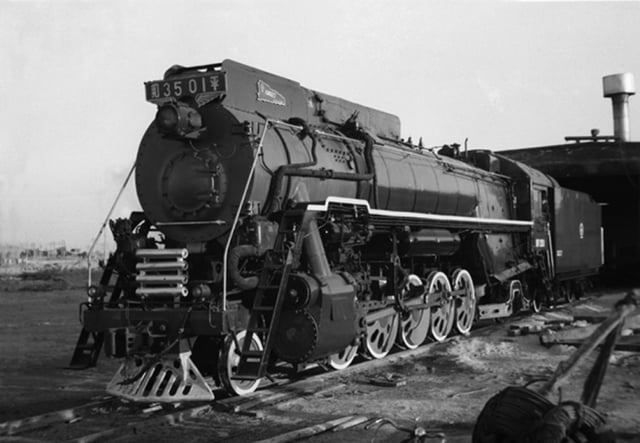
The first QJ class locomotive
The mainstay of Chinese steam was their 2-10-2 locomotives. This was the wheel arrangement of the Chinese QJ class locomotives that were based on the Soviet LV class and built by Datong Locomotive Works from 1959. They were produced until 1988 and were still in widespread service until the final steam runs in 2003.
After retirement, some of these QJ class locomotives found their way to the United States, where they are used in revenue freight and excursion service. In Train Festival 2011, Multipower International restored two Chinese IAIS 6988 locomotives to Federal Railroad Administration (FRA) Part 230 specifications and delivered them to the Railroad Development Corporation.[7]
Germany

Prussian T 20, class BR95
Examples on the German railway systems included classes BR84 and BR85, both standard tank locomotive designs built in 1935 and 1937 respectively, and class BR95, a tank locomotive built in 1922 by the Prussian State Railways as the Prussian T 20.
From 1936, the German railways built 28 three-cylinder 2-10-2 tender freight locomotives of class BR45, which were the largest steam locomotives on the system.
Further examples, still in regular service, are the metre-gauge DR Class 99.23-24 on the Harz Narrow Gauge Railways.
Mozambique
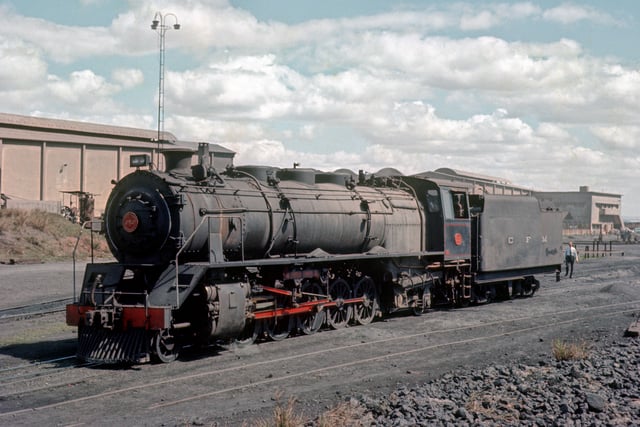
CFM Class 250 2-10-2 No. 252
While the 2-10-2 wheel arrangement was not very common in Africa, the Lourenco Marques system in Mozambique (Caminhos de Ferro de Moçambique or CFM) had altogether 37 locomotives of this type, in three classes.
Nine locomotives of the Series 200, numbered 201 to 209, were built by Baldwin Locomotive Works between 1915 and 1919.[8]
Six more Santa Fe type locomotives of the Series 214, numbered 214 to 219, were built by Henschel and Son in 1951.[8][9]
Twenty-two locomotives of the Series 250, numbered 251 to 272, were built by Henschel in 1955.[8][9]
Romania
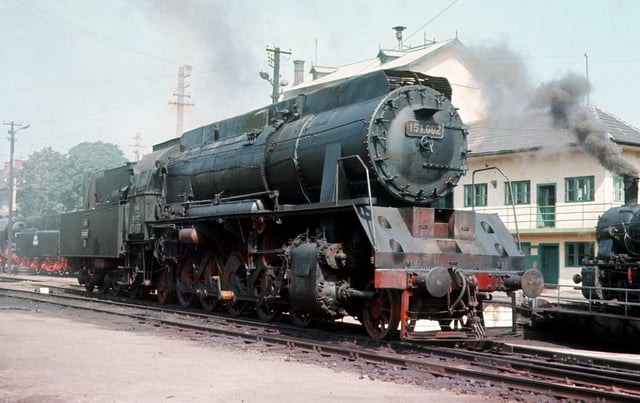
CFR 151.000 no. 151.002 at Cluj Depot
Romania designed its 151.000 Class as freight locomotives to serve on the Căile Ferate Române (CFR). These locomotives used a straightforward two-cylinder 650 by 720 millimetres (25.591 by 28.346 inches) engine with 1,500 millimetres (59 inches) diameter coupled wheels and a total weight in working order of 123 tonnes (121 long tons; 136 short tons). The heating surface of the boiler was 254.8 square metres (2,743 square feet), of which 98.5 square metres (1,060 square feet) were superheated, while the grate area was 4.72 square metres (50.8 square feet). At a tractive effort of 21,294 kilograms-force (208,820 newtons; 46,950 pounds-force), they were the most powerful steam locomotives built in Romania.[10]
Two of these locomotives were built by the Malaxa Works in 1939 and 1941, numbered 151.001 and 151.002. Number 151.002 was preserved.
South Africa
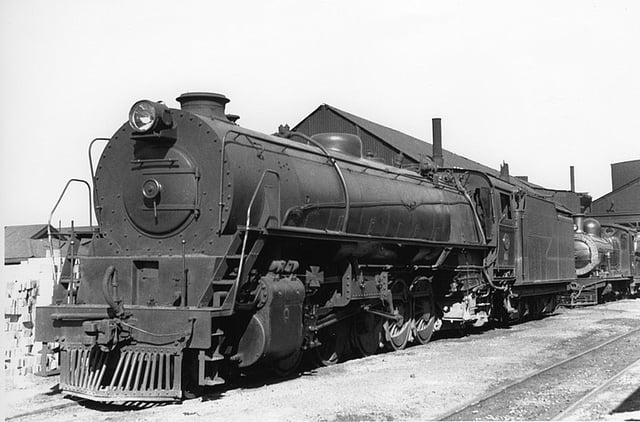
SAR Class 18
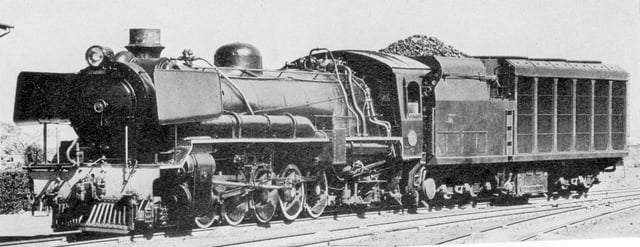
SAR Class 20 as experimental condensing locomotive
On 3 ft 6 in (1,067 mm) Cape gauge, this wheel arrangement was first used by the South African Railways (SAR) in 1927. Two Class 18 steam locomotives, the most powerful non-articulated locomotives to see service on the SAR, were introduced on the line between Witbank and Germiston in an attempt to ease problems that were being experienced with increasingly heavy coal trains. It was designed by Colonel F.R. Collins DSO, Chief Mechanical Engineer of the SAR from 1922 to 1929, and built by Henschel and Son in Germany. They were three-cylinder locomotives, with the two outer cylinders using Walschaerts valve gear and the inner cylinder using Gresley conjugated valve gear, actuated by the motions of the outer cylinders.[9][11][12][13][14]
In 1950, this sole Class 20 locomotive was modified to an experimental condensing locomotive, equipped with a condensing tender that was ordered from Henschel in Germany in 1948. Beginning in 1951, tests with the condensing Class 20 were conducted in the Eastern Transvaal and the Karoo. The positive results of the condensing trials proved the viability of condensing locomotives in South Africa and led to the introduction of the Class 25 4-8-4 condensing locomotive fleet in 1953.[9][11][12][13]
Soviet Union
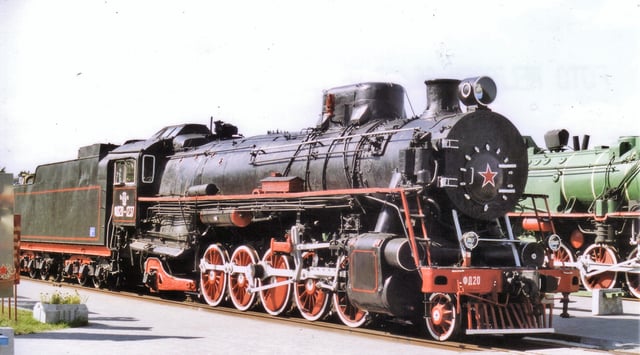
Russian locomotive class FD 2-10-2 in Brest museum
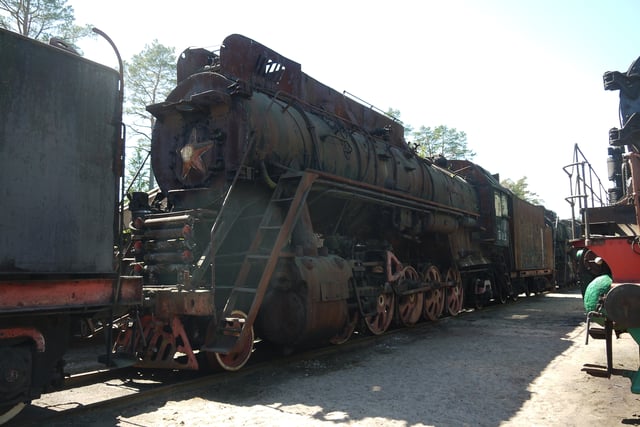
OR18-01 at Lebyazhye Railway Museum
In the Soviet Union, 2-10-2 locomotives were used to haul heavy freight trains. Two series were relatively common, the FD (for Felix Dzerzhinsky) with more than three thousand built through the 1930s, and the LV (Lebedyanskii, modified by the Voroshilovgrad factory).[15]
The FD class was developed from ALCO and Baldwin heavy freight locomotives that were imported to Soviet Russia, where they were designated as the Ta and Tb classes respectively. The first FD class locomotive was built at the Lugansk Locomotive Factory in 1931.
In 1932, the Voroshilovgradskom plant began with the mass production of ФД20 locomotives. In the process of production, their construction was improved constantly. Production was interrupted at the outbreak of the Great Patriotic war in 1941 and was only resumed in 1942, when four locomotives were built in Ulan Ude. The total production was 2,927 locomotives of ФД20, and 286 locomotives of ФД21. The two subclasses only differed in respect of their types of superheater.
In 1958, 1,054 FD class locomotives were sold to China, where they worked until the 1980s. A much lesser number were sold to North Korea at around the same time.[16]
The Russian locomotive class LV was developed from the previous L class 2-10-0 locomotive by the Voroshilovgrad factory. It used a feedwater heater to increase thermal efficiency and was the most efficient freight steam locomotive in the Soviet Union, with thermal efficiency of 9.3%. The first prototype was named OR18-01 (October Revolution factory, 18 tonne axle load). A total of 522 LV class locomotives were built. Several were preserved, including the first, OR18-01, and the last, LV-0522.
Spain
In Spain, the 2-10-2 wheel arrangement was represented by one series of 22 locomotives. They were initially ordered for the Compañía del Norte, but RENFE kept the entire series in reserve. Built between 1941 and 1944 in the La Maquinista Terrestre y Maritima SA factory in Barcelona for hauling heavy coal trains, they were amongst the most powerful steam locomotives in Europe. They had three cylinders, but used simple expansion and were known as Santa Fe locomotives.
United States of America
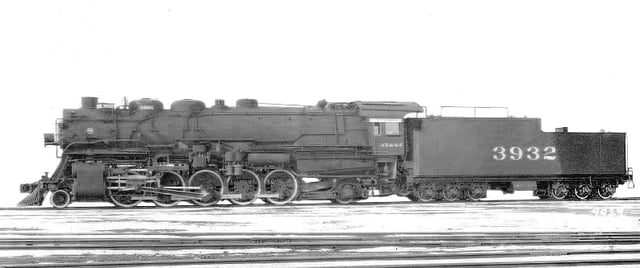
AT&SF 2-10-2 No. 3932

USRA light 2-10-2 Santa Fe
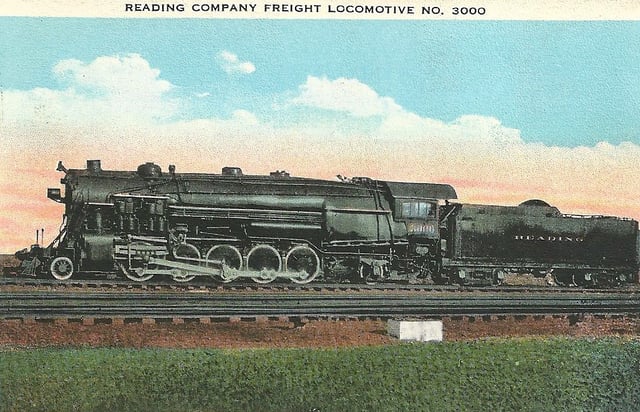
Reading Railway 2-10-2 No. 3000

Baltimore and Ohio Railroad 2-10-2 No. 6206
In the United States, the 2-10-2 type was produced between 1903 and 1930. The first were the Atchison, Topeka and Santa Fe Railway (AT&SF) engines of the 900 and 1600 series, which were an early type with few advantages over the 2-10-0 Decapod, save their ability to operate in reverse without derailing. By 1919, the AT&SF was building the definitive type, with the trailing truck supporting a large firebox. These were of the AT&SF 3800 class. One of them, AT&SF engine no. 3829, was equipped with an experimental two-axle trailing truck to become the first 2-10-4 Texas type.[2]
About 2,200 Santa Fe types were built, including about 500 of the two United States Railroad Administration (USRA) First World War standard designs. There were two USRA standard 2-10-2s, the heavy version with an engine weight of 380,000 pounds (172,365 kilograms) and the light version with an engine weight of 352,000 pounds (159,665 kilograms). The Santa Fe had the most with 352 engines.[2]
The heaviest 2-10-2s were ten locomotives built by Baldwin Locomotive Works for the Reading Railway c. 1931, weighing 451,000 pounds (204,570 kilograms), engine only.[17]
At 104,000 pounds-force (460 kilonewtons), the Illinois Central Railroad’s 2800 class rebuilds probably had the highest calculated tractive effort of any two-cylinder steam locomotive, although the adhesive weight was only 333,000 pounds (151,050 kilograms).[17]
The Baltimore and Ohio Railroad ordered its first 2-10-2 from Baldwin in 1914. From 1914 to 1956, their 2-10-2s bore numbers commencing with 6, hence the nickname "Big Sixes". Designated the S class, there were several sub-classes. The first of the Big Sixes was retired in 1951 and were all scrapped by 1960.[17]